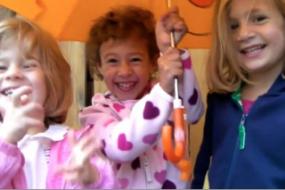The Very Social Umbrella

In this video clip, Jordan and her friends discover that an umbrella is better when shared. Jordan (heart coat) understands that the value of an umbrella is increased when it’s raining, and as the umbrella holder, she too gains social importance. Unlike a raincoat, the umbrella is unique in that its design accommodates more than one child at a time. Jordan learns that she can continue to enjoy the umbrella while choosing to also extend its benefit to others. Throughout the episode the children construct several different relationships around this ordinary, everyday object. As the clip begins, the girls introduce the umbrella as a kind of decorative artifact bearing a familiar motif. Isabella (dark purple coat) announces, “I have an umbrella too.” Jordan (heart coat) replies, “Look at our umbrella.” Isabella says, “Yeah. Ours is a ladybug,” and Jordan says, “Mine’s an elephant.” Meanwhile, Celia (sweater coat) treats the umbrella as a functional object by following along and trying to duck underneath alongside Isabella (00:08 – 00:14). The umbrella is given social significance as an object of inclusion when Sara (lavender & purple coat) approaches Jordan and asks, “Can I get under too? (00:21). Shortly thereafter, three girls duck underneath (00:28) and form a group of five. For a short time, the close shelter of the umbrella allows the girls to enjoy a sense of togetherness and fellowship (00:29 – 00:38). Next, Jordan lends a game-like quality to the girls’ experience by playfully removing the umbrella and exposing the group to the lightly falling rain, causing giggles all around (00:38 – 00:44). As some of the children pursue a new play theme, Audrey (pink coat) works to maintain her partnership with Jordan by re-joining her “inside” the umbrella (00:56). Jordan reciprocates by inviting Audrey to “come here,” as she moves to a new location. Notice that Jordan uses the umbrella as a marker to define their place on the playground (01:06). When Sara interjects an unrelated pretend script (mud pie), the portability of the umbrella allows Jordan and Audrey to simply back away a few steps (01:17). Jordan enjoys a sense of social importance as she uses the umbrella to provide shelter, create a sense of space, and foster social intimacy. Further, she has discovered that unlike many other items on the playground (tricycle, swing, sand shovel), the umbrella is an object that can be shared without needing to give it away (i.e., turn taking). As such, Jordan cleverly works to maintain control over the umbrella. At first she playfully moves it away from Sara’s grasp (01:25 – 01:29). When this strategy does not work Jordan says, “Stop” (01:30), and extends her arms to lift the umbrella up (01:33), conveying an implied message: “I will share my umbrella with you if you follow my rules.” Once again, Jordan and Audrey share the umbrella contentedly (01:53). Celia pops underneath (01:56), and in the way adults often start a conversation with acquaintances and friends, Audrey comments about the weather, stating, “It’s raining” (01:59). Observe that the umbrella serves as a kind of social pit stop as Celia leaves to rejoin a game of tag and another friend stops by. Continue watching and see how this newly formed trio revises the role of the umbrella in their social play. Think about what other objects may similarly afford young children an opportunity to experience the joy of sharing without requiring a child to fully give up control (blanket, tent, large box, etc.). Finally, this changeable object becomes a shield from the view of others (2:08), as the three girls lower the umbrella, masking their appearance. The teacher confirms the game saying, "Whose feet are those?" You can hear the girls laugh as they realize that by hiding their faces they have made their feet anonymous. They further confirm the structure of this new use of the umbrella: they do not want to see others, and at the same time, they do not want others to see them. This ordinary object, the umbrella, becomes the perfect prop for forming close social groupings, establishing individual identities, hiding from others, anchoring the use of spaces, creating power plays to be resolved, and sharing without relinquishing. Now, who thinks that an umbrella is only useful for keeping out the rain? Keywords: Threes, Child-Child, Ordinary Objects, Sharing, Creativity, Outdoor Play Length of video: 3 minutes 16 seconds
